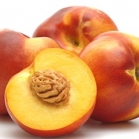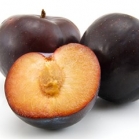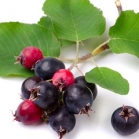Crops
Apples
view all Apples related contentThere are 11.6 million apple trees in NY (according to the 2011 USDA tree survey): Wayne County has 5.2 million trees, Orleans has 1.7 million, Niagara has 572,000, Monroe has 213,632, and Oswego has 157,808. In these counties, there are 259 apple farms growing 26,446 acres. This is 63% of the acreage in the state. Modern planting systems range from 600 to 2000 trees per acre and are supported by a trellis system or individual tree supports. The common varieties grown include McIntosh, Empire, Red Delicious, Rome, Idared, Cortland, Gala, Golden Delicious, Jonagold, Crispin, Honeycrisp, Macoun, Gingergold,and more. There are new varieties released from the Cornell Breeding program including SnapDragon and RubyFrost. Autumn Crisp is also a Cornell variety.
For more information, go to Cornell Fruit Resources: Tree Fruit.
Apricots
view all Apricots related contentApricots are a minor crop in western NY. Apricots are the first tree fruit crop to break bud in the spring and are very susceptible to early frosts. Success in growing this crop will be very dependent on site close to the lakeshore where spring temperatures are moderated by the lake delaying tree growth in the spring and maintaining spring temperatures above freezing. The variety selection is very important. Look for varieties that are resistant to bacterial spot since this disease is difficult to control.
For more information, go to Cornell Fruit Resources: Tree Fruit.
Asian Pears
view all Asian Pears related contentAsian Pears are a specialty crop for which a grower must cultivate a market for. They are very early blooming compared to Bartlett and Bosc pears. At least 2 compatible varieties are necessary for pollination. They have a reputation for being very difficult to thin requiring multiple chemical thinner applications and removing fruit by hand so the pears can grow to desirable size. There are only a few growers in WNY with Asian pears. Fruit size is the greatest barrier along with limited market demand.
For more information, go to Cornell Fruit Resources: Tree Fruit.
Blueberries
view all Blueberries related contentNew York State has a little more than 700 acres of blueberries in production yielding about 2 million pounds of blueberries annually making it the 9th most important blueberry production state in the nation. Increased consumer interest in dark colored fruit containing high amounts of healthful antioxidants has resulted in many more acres being planted over the past several years. This is despite the soil pH requirement of 4.5 that blueberries, a member of the acid-loving Ericaceae family require.
It takes nearly 8 years for blueberries to reach their mature production, but a well maintained planting can remain economically viable for up to 40 years or more yielding in excess of 10,000 lbs/acre. Ninety-five percent of this production is hand-picked and sold as fresh fruit with the remaining 5% going to value added products.
Highbush blueberries are grown throughout the majority of the state, but in northern NY and the Adirondacks, cultivars that are crosses between the Maine low-bush and northern high-bush blueberries result in a smaller bush that is much more winter hardy. The threat from late spring frosts remains a challenge to blueberry growers throughout the state. Blueberries have a relatively small pest complex making it a favorite berry for organic production.
For more information about blueberry production, visit the Cornell Fruit Resources: Berries.
Cherries
view all Cherries related contentNY growers produce sweet and tart cherries. Most tart cherries are grown in WNY and are processed into frozen cherries, pie filling, dried cherries, and cherry powder. The new products have increased consumption of cherries due to the health benefits of antioxidants in cherries. Sweet cherries are grown across the state and are commonly harvested in U-pick operations. Cherries trees will start producing cherries in about 5 years after planting and will reach their greatest production in 10 years.
Cherry trees are grafted to rootstocks to control height and require well drained soil. Tart cherries are generally self fruitful, but sweet cherries need compatible varieties for pollination.
For more information, go to Cornell Fruit Resources: Tree Fruit.
Currants
view all Currants related contentGooseberries
view all Gooseberries related contentNectarines
view all Nectarines related contentNectarines are a minor crop in WNY but can be found on farm stands produced locally. They are smooth skinned stone fruit, self-fruitful, and typically grafted to a rootstock suited for specific site conditions. Nectarines require well drained soil and should be planted near a lakeshore where they are protected from winter cold temperatures and spring frost. Different varieties have different degrees of resistance to bacterial spot, and brown rot. Nectarines tend to be more susceptible to brown rot than peaches.
For more information, go to Cornell Fruit Resources: Tree Fruit.
Peaches
view all Peaches related contentPeaches are a minor crop in WNY, with about 1200 acres in NY. They are differentiated under 3 categories - processing cling stone varieties, and fresh varieties that are cling and freestone. They are self-fruitful, and typically grafted to a rootstock suited for specific site conditions. Peaches require well drained soil and should be planted near a lakeshore where they are protected from winter cold temperatures and spring frost. Different varieties have different degrees of resistance to bacterial spot, and brown rot. peaches can be planted in high density systems but are not typically trellised. Horticultural tree training methods are critical to minimized fungal cankers that will shorten the life of peach trees.
For more information, go to Cornell Fruit Resources: Tree Fruit.
Pears
view all Pears related contentNY ranks fourth in pear production with an estimated 1000 acres. Bartlett and Bosc are the main varieties grown, and are grafted to various rootstocks. There are some new varieties to try including Magnus, Potomac, Harrow Crisp, and Sundown. Pears are typically grafted to size controlling rootstocks. Pear trees typically take many years to bear fruit, but there are horticultural methods that can help trees produce fruit earlier. Fire blight is a major bacterial disease that affects pear trees.
For more information, go to Cornell Fruit Resources: Tree Fruit.
Plums
view all Plums related contentPlums are a minor crop in WNY with many varieties to choose from. Plums are classified as European "blue plums" used for canning, drying, and fresh consumption; Japanese plums are mainly for fresh consumption. Plum trees are are not self-fruitful and need a compatible variety for pollination. They are typically grafted to a Myrobalan rootstock. Plum varieties have different degrees of tolerance to bacterial spot, and bacterial canker disease. Propogating and planting plum trees is regulated under provisions set by NY Ag & Markets depending on proximity to recent detections of plum pox virus. Check the website for an updated map for where planting and propagation is regulated.
For more information, go to Cornell Tree Fruit.
Raspberries / Blackberries
view all Raspberries / Blackberries related contentRaspberries are the most widely grown bramble crop in New York planted on over 450 acres in all regions of the state. Both floricane (summer bearing) and primocane (fall or ever-bearing) raspberries are grown and yellow, purple and black fruited cultivars in addition to the popular red raspberries make up the tasty crop. Ninety percent of the estimated 1.1 million pound annual raspberry crop is sold for fresh market and the remaining 10% is used to make value added items including preserves, juice additives and fruit wine.
Blackberries are closely related to raspberries and are grouped together with them in the 'Bramble' category of berry crops. Blackberries differ from raspberries in that the receptacle within the berry fruit is eaten along with the berry. For raspberries, the receptacle is left on the plant, leaving a hollow berry for consumption. Blackberries are also a more tender plant, successfully grown on 450 acres in more temperate regions of the state including Long Island, the Hudson Valley, the Finger Lakes region and fruiting districts near the Great Lakes.
All bramble crops need well drained soil as they are susceptible to soil borne diseases particularly Phytophthora. Potential growers should be aware of cane diseases and other pest problems, as well as the fact that raspberries and blackberries have an extremely short shelf life after harvest, making adequate post-harvest cooling essential. Brambles are often trellised adding to the production costs which can average about $4000/acre.
High tunnel production of raspberries and blackberries has been increasing throughout New York State thanks to research done by the Cornell University Department of Horticulture. This type of protected culture allows growers to extend the productive season of raspberries, extend the potential production sites of blackberries throughout the state and allows growers to produce a much higher quality fruit.
For more information about bramble culture, visit the Cornell Fruit Resources: Berries.
Strawberries
view all Strawberries related contentNew York State ranks 8th in the nation in strawberry production. Statewide there are over 1700 acres in production yielding 3.6 million pounds with a cash value of nearly 8.5 million dollars. The vast majority of the crop is sold from late May into early July as part of the June bearing crop that is grown in a perennial matted row system. This crop has a significant emotional bond with consumers. Strawberries have long been the first locally grown crop of the season. Picking strawberries is one of the most popular agricultural activities in upstate NY with most communities hosting delicious strawberry festivals. Ninety-five percent of the crop is sold this way, often picked by customers and always for immediate fresh consumption. The remaining 5% of the crop is used for value-added processing.
With the advent of ever-bearing (also called day neutral) varieties many strawberry farmers have been able to offer NY consumers high quality, locally grown fresh strawberries later in the season - from August to November. Other production innovations include growing on plastic mulch to help reduce herbicide inputs and growing strawberries in high tunnels to lower the incidence of botrytis gray mold and other pests.
For more information about strawberry production, visit the Cornell Fruit Resources: Berries.
Unusual Fruit
view all Unusual Fruit related contentUpcoming Events
2026 Dyson Agricultural Food
January 12, 2026
Ithaca, NY
The Past, the Present, and the Future of PACMAN Webinar
January 12, 2026
Join nationally recognized scientists and extension specialists for a nationwide PACMAN webinar presenting five years of research findings and outlining emerging directions and collaborative opportunities for the next phase of the project.
2026 Cornell Winter Fruit Webinars
January 22, 2026 : Blueberry Pruning and Soil Health to Minimize Pests and Maximize Yield
Week 1: Blueberry Pruning and Soil Health to Minimize Pests and Maximize Yield
January 29, 2026 : Cost of Production for Fruit Crops
Week 2: Cost of Production for Fruit Crops - A new tool for tree fruit, updates on berry production in NY, and strategies for tracking and using expense data.
February 12, 2026 : Fire Blight Management Updates
Week 3: Fire Blight Management Updates - Pathogen Biology, Defense Inducers, Biopesticides, and Pruning Therapies
February 19, 2026 : Pink and Petal Fall Insecticides - Can We Strike the Right Balance?
Week 4: Pink and Petal Fall Insecticides - Can We Strike the Right Balance?
March 12, 2026 : Inoculating Orchards with Mycorrhizal Fungi
Week 5: Inoculating Orchards with Mycorrhizal Fungi
March 19, 2026 : St. Peachtrick's Day - Cherry Pruning Strategies and Plum Varieties for the Northeast
Week 6: St. Peachtrick's Day - Cherry Pruning Strategies and Plum Varieties for the Northeast





























